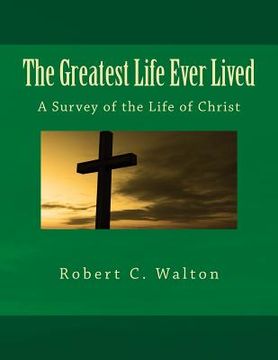Reseña del libro "The Greatest Life Ever Lived: A Survey of the Life of Christ (en Inglés)"
The life and ministry of Jesus serve as the focal point, not only of the Bible, but indeed of all human history. The entirety of God's revelation to man points toward, describes, and then flows from the incarnation, death, and resurrection of the Son of God. Thus a proper understanding of the life of Christ is essential in order to comprehend everything from Creation to Consummation, the meaning and direction of history, and the significance of each individual life. Pilate's question, "What shall I do with Jesus, who is called Christ?" (Matthew 27:22) is decisive in the eternal destiny of every person who lives on this earth. As the Apostle John indicates, the Gospel narratives were written "so that you may believe that Jesus is the Christ, the Son of God, and that by believing you might have life in His name" (John 20:31). They were intended to elicit faith in Christ as Savior, not to serve as the object of academic study. At the same time, when Jesus said to the Pharisees, "You search the Scriptures because you think that in them you have eternal life" (John 5:39), He was not criticizing their extensive study of the Word, but rather the fact that they did so without faith. The Gospels must therefore be studied with a desire to know personally the Messiah of whom they speak. Knowledge without personal application is as fruitless today as it was among the religious leaders to whom Jesus spoke two thousand years ago. The fact that God has given us four Gospels is a source of great richness in our search for the Savior of whom they speak, but it has also been the basis for much criticism. It is no accident that one of the earliest apologetic works written in the Early Church was a harmony of the Gospels (Tatian's Diatessaron). Pagan philosophers and Jewish scholars alike pointed to supposed contradictions in the Gospels in an effort to discredit their reliability and authority. In modern times, critical scholars have gone even further, denying the traditional authorship of the books and suggesting that they were written by people who lived long after the time of Christ and never knew Him personally. Studying the life of Christ in the form of a harmony, weaving the Gospel narratives together into a smooth whole, can thus serve an apologetic as well as devotional purpose, enabling the believer to "be prepared to make a defense to anyone who asks you for a reason for the hope that is in you" (I Peter 3:15). Note, however, that the task is complicated by the fact that Jesus undoubtedly said many of the things recorded in the Gospels on multiple occasions during his ministry of approximately three and a half years. Many scholars since the time of Tatian have attempted to harmonize the Gospel narratives, and the results vary in many particulars. In this text I have relied mostly on A.T. Robertson's classic Harmony of the Gospels (1932) while supplementing it with other sources. Most efforts to create a chronology of the life and ministry of Jesus have assumed that Mark, Luke, and John are basically chronological, while Matthew tends to group material topically, leading the writers to build their harmonies around either Mark or Luke. Robertson succeeds more than most in retaining the sequence of all three narratives other than Matthew, and thus I have chosen to use his work as the foundation for this book. Another issue that arises when studying the life of Christ as recorded in the Gospels is the problem of matching it with what we know about the history of the Roman Empire at the time of Jesus. Luke gives more chronological markers than the other Gospel writers, but the range of times associated with the rulers he mentions still leaves quite a bit of room for controversy. The dating scheme I have chosen to follow has Jesus being born around 6 BC, beginning His public ministry in 29 AD, and going to the Cross during the Passover in 33 AD.

